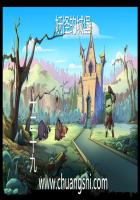What was this Virginia to which they were bound? In the sixteenth and early seventeenth centuries the name stood for a huge stretch of littoral, running southward from lands of long winters and fur-bearing animals to lands of the canebrake, the fig, the magnolia, the chameleon, and the mockingbird. The world had been circumnavigated; Drake had passed up the western coast--and yet cartographers, the learned, and those who took the word from the learned, strangely visualized the North American mainland as narrow indeed. Apparently, they conceived it as a kind of extended Central America. The huge rivers puzzled them. There existed a notion that these might be estuaries, curling and curving through the land from sea to sea.
India--Cathay--spices and wonders and Orient wealth--lay beyond the South Sea, and the South Sea was but a few days' march from Hatteras or Chesapeake. The Virginia familiar to the mind of the time lay extended, and she was very slender. Her right hand touched the eastern ocean, and her left hand touched the western.
Contact and experience soon modified this general notion. Wider knowledge, political and economic considerations, practical reasons of all kinds, drew a different physical form for old Virginia. Before the seventeenth century had passed away, they had given to her northern end a baptism of other names. To the south she was lopped to make the Carolinas. Only to the west, for a long time, she seemed to grow, while like a mirage the South Sea and Cathay receded into the distance.
This narrative, moving with the three ships from England, and through a time span of less than a hundred and fifty years, deals with a region of the western hemisphere a thousand miles in length, several hundred in breadth, stretching from the Florida line to the northern edge of Chesapeake Bay, and from the Atlantic to the Appalachians. Out of this Virginia there grow in succession the ancient colonies and the modern States of Virginia, Maryland, South and North Carolina, and Georgia.
But for many a year Virginia itself was the only settlement and the only name. This Virginia was a country favored by nature. Neither too hot nor too cold, it was rich-soiled and capable of every temperate growth in its sunniest aspect. Great rivers drained it, flowing into a great bay, almost a sea, many-armed as Briareus, affording safe and sheltered harbors.
Slowly, with beauty, the land mounted to the west. The sun set behind wooded mountains, long wave-lines raised far back in geologic time. The valleys were many and beautiful, watered by sliding streams. Back to the east again, below the rolling land, were found the shimmering levels, the jewel-green marshes, the wide, slow waters, and at last upon the Atlantic shore the thunder of the rainbow-tinted surf. Various and pleasing was the country. Springs and autumns were long and balmy, the sun shone bright, there was much blue sky, a rich flora arid fauna. There were mineral wealth and water power, and breadth and depth for agriculture. Such was the Virginia between the Potomac and the Dan, the Chesapeake and the Alleghanies.
This, and not the gold-bedight slim neighbor of Cathay, was now the lure of the Susan Constant, the Goodspeed, and the Discovery. But those aboard, obsessed by Spanish America, imperfectly knowing the features and distances of the orb, yet clung to their first vision. But they knew there would be forest and Indians. Tales enough had been told of both!
What has to be imaged is a forest the size of Virginia. Here and there, chiefly upon river banks, show small Indian clearings. Here and there are natural meadows, and toward the salt water great marshes, the home of waterfowl. But all these are little or naught in the whole, faint adornments sewed upon a shaggy garment, green in summer, flame-hued in autumn, brown in winter, green and flower-colored in the spring. Nor was the forest to any appreciable extent like much Virginian forest of today, second growth, invaded, hewed down, and renewed, to hear again the sound of the axe, set afire by a thousand accidents, burning upon its own funeral pyres, all its primeval glory withered. The forest of old Virginia was jocund and powerful, eternally young and eternally old. The forest was Despot in the land--was Emperor and Pope.
With the forest went the Indian. They had a pact together. The Indians hacked out space for their villages of twenty or thirty huts, their maize and bean fields and tobacco patches. They took saplings for poles and bark to cover the huts and wood for fires. The forest gave canoe and bow and arrow, household bowls and platters, the sides of the drum that was beaten at feasts. It furnished trees serviceable for shelter when the foe was stalked. It was their wall and roof, their habitat. It was one of the Four Friends of the Indians--the Ground, the Waters, the Sky, the Forest. The forest was everywhere, and the Indians dwelled in the forest. Not unnaturally, they held that this world was theirs.
Upon the three ships, sailing, sailing, moved a few men who could speak with authority of the forest and of Indians. Christopher Newport was upon his first voyage to Virginia, but he knew the Indies and the South American coast. He had sailed and had fought under Francis Drake. And Bartholomew Gosnold had explored both for himself and for Raleigh. These two could tell others what to look for. In their company there was also John Smith. This gentleman, it is true, had not wandered, fought, and companioned with romance in America, but he had done so everywhere else. He had as yet no experience with Indians, but he could conceive that rough experiences were rough experiences, whether in Europe, Asia, Africa, or America. And as he knew there was a family likeness among dangerous happenings, so also he found one among remedies, and he had a bag full of stories of strange happenings and how they should be met.















